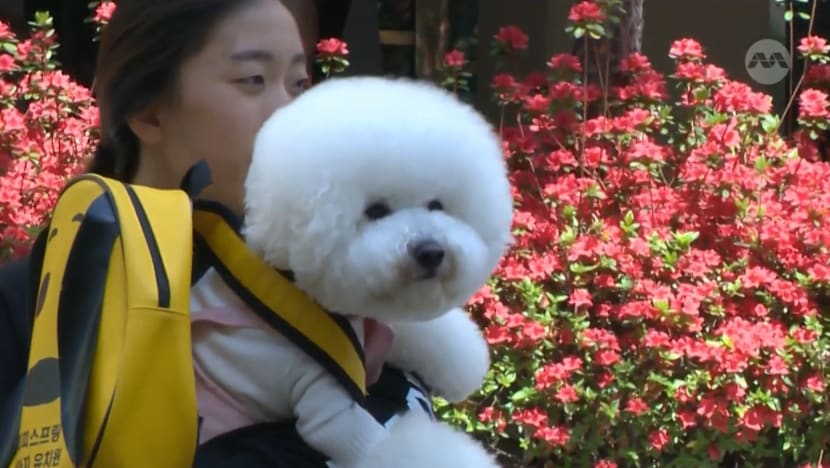Sit, stay, study: South Koreans spending big on ‘kindergarten’ for their pet dogs
The pet market in South Korea is growing rapidly, as the nation's birth rate drops and more households raise companion animals.

A toy poodle at a "dog kindergarten" in South Korea.

This audio is generated by an AI tool.
SEOUL: In a country where the birth rate has fallen to the lowest in the world, a growing number of families are turning to four-legged companions to fill a void traditionally occupied by babies.
Just like human children, these pets in South Korea are heading to “school” – complete with entrance examinations and structured curriculums, with some owners paying hundreds of dollars to secure a good place.
At pet kindergarten Dog Us Planet in capital Seoul, dogs must first undergo a three-hour test before they can join classes in obedience, socialisation and group play.
“We start with a short consultation before the temperament test,” said Kim Hyo-jin, CEO of Dog Us Planet.
“Through this, we learn what kind of environment the 'child' has been living in and how tense or relaxed it usually is at home … This is what we often call a ‘level test’.”
Unlike normal school, however, Kim said the kindergarten does not reject dogs. The test seeks to place them in the right class instead based on their nature.
Lessons include nose work – or searching for food – as well as table manners, like learning commands such as “wait” before eating. The dogs also undergo fitness classes designed to boost strength and balance.
But not all schools are as accommodating.
At Francois Pet Pangyo Center in Seongnam city, about 19km southeast of Seoul, dogs can be turned away for safety purposes if they fail its test, given that dozens of canines share the same space.
Trainers say they watch for frustration or defensive behaviour. If dogs show possessiveness, they may not be admitted.
The center offers kindergarten, daycare, grooming and boarding services.
“Owners are concerned about safety, so we have to be thorough — assessing the dog’s temperament and behaviour to provide proper care. It might feel rigid, but it ensures a safe, healthy centre,” said manager Lee Ye-jin.
15 MILLION HAD PETS IN 2022
As fewer South Korean couples have children, many are channelling their nurturing instincts into raising pets.
The country’s fertility rate hit a record low of 0.72 in 2023 - far below the replacement level of 2.1 needed to maintain a stable population. But this rose last year for the first time in nine years to 0.75, supported by an increase in marriages.
According to South Korea's Ministry of Agriculture, Food and Rural Affairs, about 15 million people in the country were raising pets as of end-2022, with a majority having dogs.
The size of the related market stood at about US$5.7 billion then and is estimated to reach about US$15 billion by 2027.
Like children’s education, pet education in the country does not come cheap.
According to the Korea Consumer Agency, the average monthly cost for a dog to attend kindergarten in Seoul last year was about 255,000 won (US$180) - higher than the average cost of early childhood education in the capital city.
As the pet industry grows in South Korea, experts say demand will not just be for kindergartens, but also senior dog care as these “children” age alongside their owners.
For dogs that do not make the cut at “schools”, they often head to training academies first where they receive targeted behaviour modification.
Dog Us Planet’s Kim noted that South Koreans often head out to work or school in the day, leaving the house empty with no companionship for their pets.
“Many guardians come to prevent problems that arise when dogs are left home alone for too long. They feel their dogs need education, though not to the level of a full training school,” she added.
“In Korea, pets are seen as family members - like children.”



















